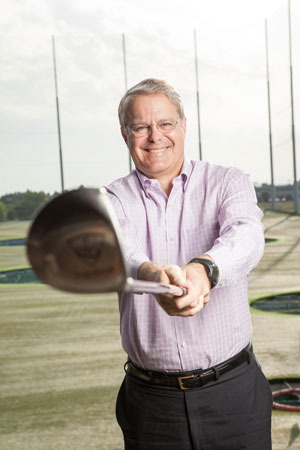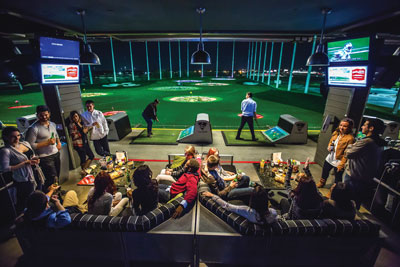While the golf industry as a whole is pitching millennials to come play the game, one company is already finding its way with that younger demographic thanks to its nontraditional setup. At Topgolf, the formula is more nightclub than country club: dancing, DJs and happy hours for both casual and corporate outings.
Topgolf’s version of golf has its roots in the British Isles. In 2000, two brothers in a London suburb hatched the idea of putting microchips in golf balls to see whose strokes went farther and traveled more accurately. Fifteen years later, the company owns and operates 13 locations in the U.S. and three in the U.K. and has aims on expansion.
 |
Ken May: “We’re not stealing golfers from golf.”
Photo by: TOPGOLF |
The privately held company declined to disclose its financials, but it touts an expected 8 million customers at its facilities this year. Two or three instructors are staffed at each Topgolf location, and while the company has no official ties to golf’s leading governing bodies, the game’s stewards appear to be embracing its concept.
“We are bullish on Topgolf; it skews more millennial than the industry,” said Steve Mona, CEO of the World Golf Foundation, which works to develop the game worldwide. “We think it will become a great avenue to the [traditional] game of golf.”
Topgolf’s CEO, Ken May, recently discussed the company’s path to the green with correspondent Robert D. Gray.
■ How would you describe Topgolf?
MAY: It takes the driving-range experience and turns it on its head and makes it a lot more enjoyable. You hit balls with microchips in them; they know which player in a driving bay hit the ball. You aim at targets, similar to darts, and you score points. A beginner can compete with someone who can hit the ball farther. We provide clubs for you [and] you can play a game or a lot of games of Topgolf in an hour or two instead of a five-hour round.
■ Who are Topgolf’s customer?
MAY: They are 70 percent male, 70 percent describe themselves as physically active, 56 percent are ages 18-34. Gen Xers are the second-biggest group. Our guests are pretty well-to-do: The average income is $100,000 a year. They are younger, physically active, high-wage earners that are social media active, [but] Topgolf is an all-ages facility with a KidZone program.
■ How much does a typical outing cost?
MAY: Memberships start at $5, a one-time cost that includes complimentary club rentals, and it costs $20 to $45 per hour for a group of six to play, depending on location. The average group size is four and stays for two hours and two minutes.
■ Where does the bulk of your revenue come from?
 |
Topgolf has 13 locations in the U.S. and nine more under construction.
Photos by: TOPGOLF (2)
|
MAY: Games, followed by food and beverage, then events — social and corporate.
■ Who are your competitors?
MAY: They are primarily in the entertainment space, businesses like high-end bowling alleys, Dave & Buster’s, [and] iPic or Alamo Drafthouse movie theaters.
■ What are your expansion plans?
MAY: We have nine locations
under construction and just announced a flagship in Las Vegas at the MGM Grand. That will be 105,000 square feet on four levels.
We employ approximately 5,300 associates today and will have 10,000 by year-end. Right now we’re focusing on U.S. expansion, then we’ll look for a way to get into Asia.
■ Do you think Topgolf is helping raise golf’s profile?
MAY: I believe we’re helping grow the game of golf. Over half of our [expected] 8 million customers this year will have played golf one time or less. That’s 4 million people tasting golf through Topgolf. Our challenge is taking people through Topgolf and getting them to go to a course.
■ How do you answer critics who say Topgolf is not authentic golf?
MAY: I’d encourage them to come play one of our leagues where people are competing against each other. There’s certain parts of the traditional game that are pretty boring; we feel like we’re going right at them. We’re not stealing golfers from golf; we’re bringing more people into the sport and hopefully getting them to play regular golf.
Robert D. Gray is a writer in Los Angeles.







